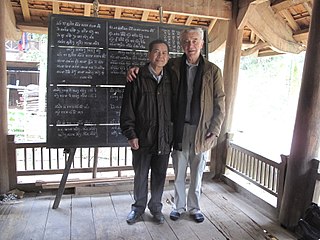Qiangic is a group of related languages within the Sino-Tibetan language family. They are spoken mainly in Southwest China, including Sichuan and northern Yunnan. Most Qiangic languages are distributed in the prefectures of Ngawa, Garzê, Ya'an and Liangshan in Sichuan with some in Northern Yunnan as well.
Naxi, also known as Nakhi, Nasi, Lomi, Moso, Mo-su, is a Sino-Tibetan language or group of languages spoken by some 310,000 people, most of whom live in or around Lijiang City Yulong Naxi Autonomous County of the province of Yunnan, China. Nakhi is also the ethnic group that speaks it, although in detail, officially defined ethnicity and linguistic reality do not coincide neatly: there are speakers of Naxi who are not registered as "Naxi" and citizens who are officially "Naxi" but do not speak it.

Leizhou or LuichewMin is a branch of Min Chinese spoken in Leizhou city, Xuwen County, Mazhang District, most parts of Suixi County and also spoken inside of the linguistically diverse Xiashan District. In the classification of Yuan Jiahua, it was included in the Southern Min group, though it has low intelligibility with other Southern Min varieties. In the classification of Li Rong, used by the Language Atlas of China, it was treated as a separate Min subgroup. Hou Jingyi combined it with Hainanese in a Qiong–Lei group.

The Gyalrongic languages constitute a branch of the Qiangic languages of Sino-Tibetan, but some propose that it may be part of a larger Rung languages group and do not consider it to be particularly closely related to Qiangic but suggest that similarities between Gyalrongic and Qiangic may be from areal influence. However, other work suggests that Qiangic as a whole may in fact be paraphyletic, with the only commonalities of the supposed "branch" being shared archaisms and areal features that were encouraged by language contact. Jacques & Michaud (2011) propose that Qiangic including Gyalrongic may belong to a larger Burmo-Qiangic group based on some lexical innovations.
Baima is a language spoken by 10,000 Baima people, of Tibetan ethnicity, in north-central Sichuan Province and Gansu Province, China. Baima is passed on from parents to children in Baima villages. It is spoken within the home domain and is not used in any media of mass communication.
Primarily in Austroasiatic languages, in a typical word a minor syllable is a reduced (minor) syllable followed by a full tonic or stressed syllable. The minor syllable may be of the form or, with a reduced vowel, as in colloquial Khmer, or of the form with no vowel at all, as in Mlabri 'navel' and 'underneath', and Khasi kyndon 'rule', syrwet 'sign', kylla 'transform', symboh 'seed' and tyngkai 'conserve'.

The Lolo-Burmese languages of Burma and Southern China form a coherent branch of the Sino-Tibetan family.
The Loloish languages, also known as Yi and occasionally Ngwi or Nisoic, are a family of fifty to a hundred Sino-Tibetan languages spoken primarily in Yunnan province of China. They are most closely related to Burmese and its relatives. Both the Loloish and Burmish branches are well defined, as is their superior node, Lolo-Burmese. However, subclassification is more contentious.

The Tibeto-Burman languages are the non-Sinitic members of the Sino-Tibetan language family, over 400 of which are spoken throughout the Southeast Asian Massif ("Zomia") as well as parts of East Asia and South Asia. Around 60 million people speak Tibeto-Burman languages. The name derives from the most widely spoken of these languages, Burmese and the Tibetic languages, which also have extensive literary traditions, dating from the 12th and 7th centuries respectively. Most of the other languages are spoken by much smaller communities, and many of them have not been described in detail.

Guillaume Jacques is a French linguist who specializes in the study of Sino-Tibetan languages: Old Chinese, Tangut, Tibetan, Gyalrongic and Kiranti languages. He also performs research on the Algonquian and Siouan language families and publishes about languages of other families such as Breton. His case studies in historical phonology are set in the framework of panchronic phonology, aiming to formulate generalizations about sound change that are independent of any particular language or language group.
Proto-Tibeto-Burman is the reconstructed ancestor of the Tibeto-Burman languages, that is, the Sino-Tibetan languages, except for Chinese. An initial reconstruction was produced by Paul K. Benedict and since refined by James Matisoff. Several other researchers argue that the Tibeto-Burman languages sans Chinese do not constitute a monophyletic group within Sino-Tibetan, and therefore that Proto-Tibeto-Burman was the same language as Proto-Sino-Tibetan.
William Hubbard Baxter III is an American linguist specializing in the history of the Chinese language and best known for his work on the reconstruction on Old Chinese.
The Naic or Naxish languages are a group of Sino-Tibetan languages that include Naxi, Na (Mosuo), Shixing (Xumi), and Namuyi (Namuzi). They have been variously classified as part of the Loloish or the Qiangic branch of Sino-Tibetan.
The Burmo-Qiangic or Eastern Tibeto-Burman languages are a proposed family of Sino-Tibetan languages spoken in Southwest China and Myanmar. It consists of the Lolo-Burmese and Qiangic branches, including the extinct Tangut language.

Michel Ferlus was a French linguist who specialized in the historical phonology of languages of Southeast Asia. In addition to phonological systems, he also studied writing systems, in particular the evolution of Indic scripts in Southeast Asia.
Panchronic phonology is an approach to historical phonology. Its aim is to formulate generalizations about sound changes that are independent of any particular language or language group.
The Naish languages are a low-level subgroup of Sino-Tibetan languages that include Naxi, Na (Mosuo), and Laze.
Laze, rendered in Chinese as Lare (拉热) and Shuitianhua (水田话), is a language of the Naish subbranch of the Naic group of languages, spoken in Muli County, western Sichuan, China.
Na is a language of the Naish subbranch of the Naic group of the Sino-Tibetan languages.






